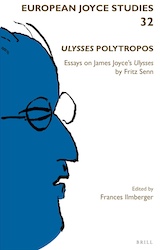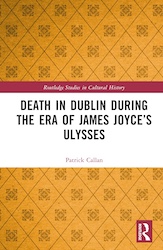Joyce Criticism: Ulysses 2000-Present
- At April 29, 2022
- By Great Quail
- In Joyce
 0
0
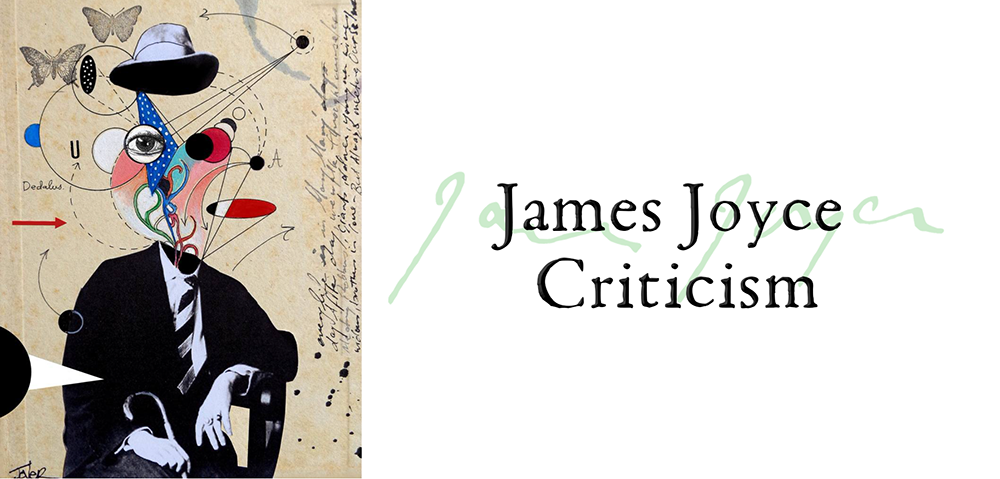
Joyce Criticism: Ulysses 2000-Present
This page profiles annotations, guides, and criticism related to Ulysses written from 2000 to the Present. They are listed in chronological order of publication. Clicking the image of a book takes you directly to Amazon.com. When Brazen Head commentary is unavailable, the publisher’s summaries are usually reprinted. If any knowledgeable Joyce reader would like to review, summarize, or provide additional information for any of these “uncommented” books, please drop us a line!
Ulysses Criticism
[Annotated Editions | Criticism 1927-1999 | Criticism 2000-Present]
Joyce’s Revenge: History, Politics, and Aesthetics in Ulysses

Joyce’s Revenge: History, Politics, and Aesthetics in Ulysses
By Andrew Gibson
Oxford University Press, 2002
Available online at: Internet Archive
An examination of Ulysses as an Irish text written by an Irish writer. Bob Williams of the Brazen Head wrote a detailed review of Joyce’s Revenge shortly after it was published.
James Joyce’s Ulysses: A Casebook
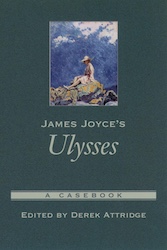
James Joyce’s Ulysses: A Casebook
Edited by Derrick Attridge
Oxford University Press, 2004
Publisher’s Description: This casebook includes some of the most influential critics to have written on Joyce, such as Hugh Kenner and Fritz Senn, as well as newer voices who have made a considerable impact in recent years. A wide range of critical schools is represented, from textual analysis to historical and psychoanalytic approaches, from feminism to post-colonialism. One essay considers the relation between art and life, nature and culture, in Ulysses, while another explores the implications of the impassioned debates about the proper editing of Joyce’s great work. In an iconoclastic discussion of the book, Leo Bersani finds reasons for giving up reading Joyce. All the contributions are characterized by scrupulous attention to Joyce’s words and a sense of the powerful challenge his work offers to our ways of thinking about ourselves, our world, and our language. Also included are records of some of the conversations Joyce had with his friend Frank Budgen during the composition of Ulysses in Zurich, and in an appendix readers will find a version of the schema which Joyce drew up as a guide to his book. Derek Attridge provides an introduction that offers advice on reading Ulysses for the first time, an account of the remarkable story of its composition, and an outline of the history of the critical reception that has played such an important part in our understanding and enjoyment of this extraordinary work.
Ulysses Unbound: A Reader’s Companion to James Joyce’s Ulysses
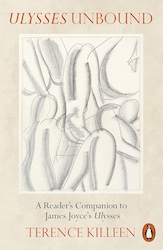
Ulysses Unbound: A Reader’s Companion to James Joyce’s Ulysses
By Terence Killeen
First Edition: Wordwell, 2004
Third Edition: University of Florida Press, 2014
Fourth Edition: Penguin, 2022
Publisher’s Description (3rd): Ideal for readers new to Ulysses and written with a depth of knowledge invaluable to scholars, Ulysses Unbound is a clear and comprehensive guide to James Joyce’s masterpiece from one of the foremost Dublin-based Joyce experts. Terence Killeen discusses the novel’s eighteen episodes individually. For each episode, Killeen provides a brief narrative summary along with an account of the parallels from Homer’s Odyssey. Next, he devotes attention to the episode’s unique style, in recognition of the novel’s remarkable stylistic diversity. He also includes a commentary section that surveys the episode’s principal themes and function within the broader context of the development of the work as a whole. These sections are followed by notes that help explain some of the main characters and historical events in the text, illuminating the real people who provided so much of the book’s material. Glossaries define many of the foreign language terms that pepper the text. Mindful of the needs of readers tackling Ulysses for the first time, Killeen begins his treatment of the episodes simply and expands his discussions as the novel’s text expands. He concludes with an overall reading of Ulysses that considers possible approaches to interpreting the book in its entirety. The guide also features a brief account of Joyce’s life and a description of the novel’s eventful textual and publishing history. Accessible and authoritative, Ulysses Unbound is an indispensable companion for both students and specialists.
Publisher’s Description (4th): In this new edition, published to celebrate the centenary of Ulysses’ first publication in 1922, Killeen seamlessly combines close literary analysis with a broad account of the novel’s fascinating history, from its writing and publication to its long contemporary afterlife. We get under the skin of the text to discover the joys of Joyce’s remarkable range of themes, styles and voices, as Killeen reanimates the real people who inspired many of the characters. Ulysses Unbound is an indispensable, illuminating and entertaining companion to one of the twentieth century’s great works of art. With a foreword by Colm Tóibín.
yes I said yes I will Yes: A Celebration of James Joyce, Ulysses, and 100 Years of Bloomsday

yes I said yes I will Yes: A Celebration of James Joyce, Ulysses, and 100 Years of Bloomsday
Edited by Nola Tully
Vintage, 2004
Available online at: Internet Archive
Released by Vintage to mark the Bloomsday centennial, this small book is billed as “a celebration of James Joyce, Ulysses, and 100 years of Bloomsday.” (Though I could quibble with the whole “100 years of Bloomsday,” as eighteen of them were, well, fictional.) It’s essentially a hodge-podge of material arranged in easy-to-digest fragments: short essays, lists, quotes, photos, trivia, and so on. Particularly useful are a few pages of annotated Joyceana: books, film, music, and art based on Joyce or his work. (Sound familiar? Rest assured, it is—perhaps a bit too familiar.) Strangely, the book’s “selected Web sites” section provides a list of URLs only, without name or annotation, some of which are woefully out of date. Still, Tully’s Yes makes for an interesting and often enjoyable read, whether gulped down in one sitting, or set aside as an upscale bathroom book.
Additional commentary from Bob Williams: Although the material on Joyce and Ulysses is essential, the most interesting and original part of the book is its discussion of Bloomsday. There is a generous amount of front and back matter, from a too-brief introduction by Isaiah Sheffer to a map of Dublin best viewed through a magnifying glass. While some of the pictures are rare and therefore useful, more material on Bloomsday would have made for a better book. Nola Tully writes the connective passages in a clear and concise manner. Unfortunately, there is too little specific dating of some statements, and so the reader occasionally struggles with chronology. The trivia is entertaining, especially regarding various reactions to Ulysses. There is a fine boiling of vituperation from conservatives and a small amount of repetition. Judge Woolsey makes more than one appearance with much the same words in the one place as in the other. We learn, if we did not already know, that Virginia Woolf either hated Ulysses or despised Joyce, depending on her mood at the time. Some surprising writers—Tennessee Williams and Henry Miller—also disliked Ulysses. Oddly, the book fails to draw Lord Dunsany or Edmund Gossett forward against Ulysses or H.G. Wells forward in approval. Another omission is its failure to mention Stephen Joyce—although an excerpt from Robert Spoo presupposes that we all know about Joyce’s grandson, the controversial executor of the Joyce Estate.
One of the more interesting sections of the book charts the critical assessment of ten eminent critics (1922) upon a variety of contemporary persons and things. One interested in that period could spend much time poring over this section, which ranges from Aristotle to Krazy Kat. (Unfortunately the chart only shows a fraction of the 201 subjects originally scored.) James Joyce scores 11.5 out of a possible 25, placing him between St. Francis and Sophicles.
Yes is a timely and pleasant book. It is not meant to be comprehensive in any respect, but it avoids errors, and can provide amusing reading for an evening.
Ulysses and Us: The Art of Everyday Life in Joyce’s Masterpiece
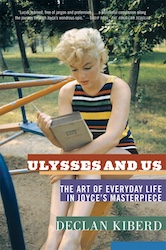
Ulysses and Us: The Art of Everyday Life in Joyce’s Masterpiece
Edited by Declan Kiberd
W.W. Norton, 2009
Available online at: Internet Archive
First published by Faber and Faber as Ulysses and Us: The Art of Everyday Living, Kiberd’s book acquired a minor change in title on its way across the pond. The paperback version also has the virtue of featuring Marilyn Monroe!
Publisher’s Description: Declan Kiberd, a professor of Anglo-Irish literature at the University College Dublin, offers an audacious new take on Joyce’s classic novel. Ulysses, he argues, is a work written for and about the common person, offering a humane vision of a more tolerant and decent life in the modern world. In this passionate corrective to the widespread view of Ulysses as an esoteric tome for the scholarly few, Kiberd dispells the aura of academic mystique that has attached itself to the novel, opening our eyes to Ulysses as a celebration of the everyday and a model for living well in an unpredictable world.
Roll Away the Reel World: James Joyce and Cinema
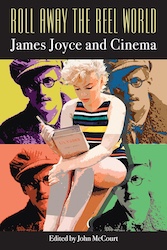
Roll Away the Reel World: James Joyce and Cinema
Edited by John McCourt
Cork University Press, 2010
A collection of essays own Joyce and cinema. The book’s page at the Cork University Press collects a few informative reviews.
Publisher’s Description: Traces Joyce’s involvement in early modern cinema, his thematic and formal borrowing from this genre, and the impact of his writings on later avant-garde and mainstream cinema ranging from Godard to Rossellini to Scorsese. Written by an international group of leading Joyce and film studies scholars, the first section of the book provides a revealing account of the writer’s central involvement in 1909-10 in setting up the Volta cinema, the first specifically-designated cinematic space opened in Dublin. The main body of the book traces aesthetic and structural links between Joyce and film, offering chapters on the birth of modern cinema as seen from Joyce’s position in Trieste, a surprising vibrant “capital” of cinema, examining the impact on Joyce of early film makers such as the Lumière brothers, Cretinetti, and Méliès, and assessing the influence of Joyce’s writings on contemporary film directors. The presence of Joyce’s Ulysses is traced in films such as American Beauty (Mendes, 1999) and The Departed (Scorsese, 2006) while various film treatments of Joyce’s work—such as John Huston’s The Dead—are also analysed.
Contents:
- John McCourt: Introduction—“From the real to the reel and back: explorations into Joyce and cinema”
- Luke McKernan, “James Joyce and the Volta Programme”
- Erik Schneider, “Dedalus Among the Film Folk: Joyce and the Cinema Volta”
- Katherine Mullin, “Joyce, Early Cinema and the Erotics of Everyday Life”
- Maria DiBattista, “The Ghost Walks: Joyce and the Spectres of Silent Cinema”
- Philip Sicker, “Mirages in the Lampglow: Joyce’s ‘Circe’ and Méliès’ Dream Cinema”
- Carla Marengo Vaglio, “Futurist Music Hall and Cinema”
- Marco Camerani, “Circe’s Costume Changes: Bloom, Fregoli and Early Cinema”
- Cleo Hanaway, “‘See Ourselves as Others See Us’: Cinematic Seeing and Being in Ulysses”
- Louis Armand, “JJ/JLG”
- Kevin Barry, “Tracing Joyce: ‘The Dead’ in Huston and Rossellini”
- Keith Williams, “Odysseys of Sound and Image: ‘Cinematicity’ and the Ulysses Adaptations”
- Jesse Meyers, “James Joyce, Subliminal Screenwriter?”
- Appendix
- Volta Filmography
Ulysses in Focus: Genetic, Textual, and Personal Views
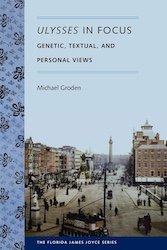
Ulysses in Focus: Genetic, Textual, and Personal Views
By Michael Groden
University Press of Florida, 2010
Publisher’s Description: Bringing together twelve essays in three areas of Joyce criticism and scholarship, this refreshing book offers various personal adventures from a life lived with Joyce’s work. In a manner that is at once modest, rigorous, and accessible, Ulysses in Focus engagingly connects these scholarly developments and contretemps to the author’s personal history and provides fascinating new genetic readings of several episodes of Ulysses that advance our understanding of the novel’s composition.
Contents:
1. The Archive in Transition: The National Library of Ireland’s New Joyce Manuscripts
2. When First I Saw, Part 1: Choosing and Being Chosen by Ulysses
3. From Monument to Mobile: Genetic Criticism and Ulysses
4. When First I Saw, Part 2: Discovering Joyce’s Manuscripts
5. The James Joyce Archive and Hans Walter Gabler’s Edition of Ulysses: A Personal History
6. Revisiting the “Cyclops” Manuscripts, Part 1: Wandering in the Avant-texte
7. Revisiting the “Cyclops” Manuscripts, Part 2: The National Library of Ireland Draft and Its Contexts
8. Mobile Pages: Ulysses in Print and on a Screen
9. Mobile Notes: Annotating Ulysses in Print and on a Screen
10. The Case of the Snuffed Footnote: A Report from the Stacks
Epilogue: Privacy in Bloom
Appendix 1. Remarks on the National Library of Ireland’s Newly Acquired Joyce Manuscripts
Appendix 2. Extant Manuscripts for Ulysses as of Summer 2002: A Chart
The Most Dangerous Book: The Battle for James Joyce’s Ulysses
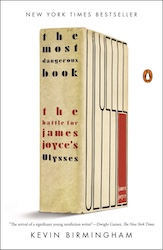
The Most Dangerous Book: The Battle for James Joyce’s Ulysses
By Kevin Birmingham
Penguin, 2014
Available Online at: Internet Archive
Also available as: Brilliance Audiobook
Publisher’s Description: For more than a decade, the book that literary critics now consider the most important novel in the English language was illegal to own, sell, advertise or purchase in most of the English-speaking world. James Joyce’s big blue book, Ulysses, ushered in the modernist era and changed the novel for all time. But the genius of Ulysses was also its danger: it omitted absolutely nothing. All of the minutiae of Leopold Bloom’s day, including its unspeakable details, unfold with careful precision in its pages. The New York Society for the Suppression of Vice immediately banned the novel as “obscene, lewd, and lascivious.” Joyce, along with some of the most important publishers and writers of his era, had to fight for years to win the freedom to publish it. The Most Dangerous Book tells the remarkable story surrounding Ulysses, from the first stirrings of Joyce’s inspiration in 1904 to its landmark federal obscenity trial in 1933. Birmingham’s archival work brings to light new information about both Joyce and the story surrounding Ulysses. Written for ardent Joyceans as well as novices who want to get to the heart of the greatest novel of the twentieth century, The Most Dangerous Book is a gripping examination of how the world came to say yes to Ulysses.
Joyce’s Creative Process and the Construction of Characters in Ulysses: Becoming the Blooms
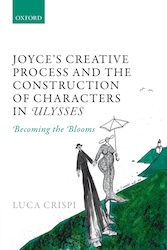
Joyce’s Creative Process and the Construction of Characters in Ulysses: Becoming the Blooms
By Luca Crispi
Oxford University Press, 2015
Sam Slote wrote a very positive review of this book for the Irish Times: “Joyce criticism has long since passed the point of supersaturation, with the result that many new books and articles reprise previously made but forgotten arguments and discoveries. In welcome contrast, Luca Crispi’s new book is a rare beast, a thorough and thoroughly original analysis of Ulysses.”
Publisher’s Description: This book is both a study of how James Joyce created two of the most iconic characters in literature―Leopold Bloom and Marion Tweedy Bloom―as well as a history of the genesis of Ulysses. From a genetic critical perspective, it explores the conception and evolution of the Blooms as fictional characters in the work’s wide range of surviving notes and manuscripts. At the same time, it also chronicles the production of Ulysses from 1917 to its first edition in 1922 and beyond. Based on decades of research, it is an original engagement with the textual archive of Ulysses, including the exciting, recently-discovered manuscripts now in the National Library of Ireland. Framed by a contextual introduction and four bibliographical appendices, the seven main chapters are a critical investigation of the fictional events and memories that constitute the “lives” of the Blooms. Thereby, it is also a commentary on Joyce’s conception of Ulysses more generally. Crispi analyzes how the stories in the published book achieved their final form and discloses previously unexamined versions of them for everyone who enjoys reading Ulysses.
James Joyce and the Phenomenology of Film
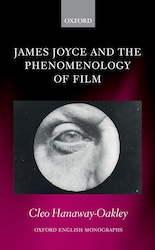
James Joyce and the Phenomenology of Film
Edited Cleo Hanaway-Oakley
Oxford University Press, 2017
Publisher’s Description: James Joyce and the Phenomenology of Film reappraises the lines of influence said to exist between Joyce’s writing and early cinema and provides an alternative to previous psychoanalytic readings of Joyce and film. Through a compelling combination of historical research and critical analysis, Cleo Hanaway-Oakley demonstrates that Joyce, early film-makers, and phenomenologists (Maurice Merleau-Ponty, in particular) share a common enterprise: all are concerned with showing, rather than explaining, the “inherence of the self in the world.” Instead of portraying an objective, neutral world, bereft of human input, Joyce, the film-makers, and the phenomenologists present embodied, conscious engagement with the environment and others: they are interested in the world-as-it-is-lived and transcend the seemingly-rigid binaries of seer/seen, subject/object, absorptive/theatrical, and personal/impersonal. This book re-evaluates the history of body- and spectator-focused film theories, placing Merleau-Ponty at the centre of the discussion, and considers the ways in which Joyce may have encountered such theories. In a wealth of close analyses, Joyce’s fiction is read alongside the work of early film-makers such as Charlie Chaplin, Georges Méliès, and Mitchell and Kenyon, and in relation to the philosophical dimensions of early-cinematic devices such as the Mutoscope, the stereoscope, and the panorama. By putting Joyce’s literary work—Ulysses above all—into dialogue with both early cinema and phenomenology, this book elucidates and enlivens literature, film, and philosophy.
The Necessary Fiction: Life with James Joyce’s Ulysses
The Necessary Fiction: Life with James Joyce’s Ulysses
By Michael Groden
First Edition: Edward Everett Root, 2019
Second Revised & Expanded Edition: Edward Everett Root, 2021
Publisher’s Description: This unusual book is a fascinating work of personal criticism or “biblio-memoir” which will appeal to all interested in James Joyce’s work, and, more widely, to those interested in responses to great art. It focusses on the life-long appeal of a particular work of art on a single individual who has been a leading Joyce scholar for 40 years. Professor Groden has taught Ulysses to undergraduates, to graduate students, and to adults outside of universities in a long and distinguished career. He is the author of two often-cited scholarly books on Joyce’s novel, and he has overseen the 63-volume facsimile reproduction of his manuscripts.
Groden says: “I’ve often been asked why I’ve devoted so much of my life to Joyce’s novel. The Necessary Fiction tries to answer that question. I wrote the book partly with seasoned readers and scholars of Ulysses in mind, but I aimed it especially at readers who desire to read, have attempted to read, or have even succeeded in reading Joyce’s novel and who will welcome an accessible, very personal introduction to it as well as a case for reading or rereading it. A neologism that has been applied to my work—‘autobloomography’—captures what I am trying to do in The Necessary Fiction. The first half of the book considers various possible reasons for Ulysses’ powerful impact on me when I read it as a 19-year-old undergraduate at Dartmouth College and later worked on Joyce’s manuscripts for his novel as a graduate student at Princeton University. This section deals with each reason in relation to a significant person in my early life. The second half discusses Ulysses’ continuing fascination for me in my professional adult life as a university professor and Joyce scholar. Throughout the book, I’ve interspersed accounts of my life with Ulysses with analyses of the novel itself.”
The Ulysses Trials: Beauty and Truth Meet the Law

The Ulysses Trials: Beauty and Truth Meet the Law
By Joseph M. Hassett
The Lilliput Press, 2016
Publisher’s Description: The publishers of Ulysses by James Joyce were brought to trial and convicted of obscenity in the USA in 1921. The immortal prose, ultimately recognized as the greatest English language novel of the twentieth century, was first published by the pioneering literary magazine The Little Review. Its founder Margaret Anderson along with her publishing partner and lover, Jane Heap, were famously convicted of a crime for their extraordinary contribution to society. From then until its eventual publication in the US in 1934 the book ran the gamut of legal obstruction. The Ulysses Trials chronicles that progress and adds not only to the understanding of Joyce but also to the history of the laws of obscenity, censorship and freedom of speech. Its appeal is to Joyceans, all those interested in modernism and to the legal community and students of literature and law. The author is a fluent writer and through his experience as a lawyer he brings a deep understanding and analysis to the course of the court proceedings and the workings and ramifications of each case. He weaves a narrative of the text of Ulysses, the contemporaneous historical context and the motives of the players (John Quinn, Judge Woolsey et al) involved in each step of the trial. His manuscript is unique given his legal perspective on such a milestone legal battle over obscenity laws and hence freedom of speech in the English speaking world in the early twentieth century. Period photographs by Man Ray and others bring this fascinating story to life.
Ulysses: A Reader’s Odyssey

Ulysses: A Reader’s Odyssey
By Daniel Mulhall
New Island Books, 2022
Written by the Irish ambassador to the United States, Ulysses: A Reader’s Odyssey is a memoir of a lifetime spent in the company of Ulysses. The book was published in celebration of the Ulysses centennial, and contains many delightful observations, even if it suffers from an accessional lack of focus. The Brazen Head published a full review of Ulysses: A Reader’s Odyssey in July 2022.
Publisher’s Description: Marking the centenary of Ireland’s—and possibly the world’s—most famous novel, this joyful introductory guide opens up Ulysses to a whole new readership, offering insight into the literary, historical and cultural elements at play in James Joyce’s masterwork. Both eloquent and erudite, this book is an initiation into the wonders of Joyce’s writing and of the world that inspired it, written by Daniel Mulhall, Ireland’s ambassador to the United States and an advocate for Irish literature around the world. One hundred years on from that novel’s first publication, Ulysses: A Reader’s Odyssey takes us on a journey through one of the twentieth century’s greatest works of fiction. Exploring the eighteen chapters of the novel and using the famous structuring principle of Homer’s Odyssey as our guide, Daniel Mulhall releases Ulysses from its reputation of impenetrability, and shows us the pleasure it can offer us as readers.
The Guide to James Joyce’s Ulysses
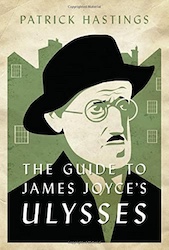
The Guide to James Joyce’s Ulysses
By Patrick Hastings
Johns Hopkins University Press, 2022
Also available as: Tantor Audiobook
Publisher’s Description: From the creator of UlyssesGuide.com, this essential guide to James Joyce’s masterpiece weaves together plot summaries, interpretive analyses, scholarly perspectives, and historical and biographical context to create an easy-to-read, entertaining, and thorough review of Ulysses. In The Guide to James Joyce’s Ulysses, Patrick Hastings provides comprehensive support to readers of Joyce’s magnum opus by illuminating crucial details and reveling in the mischievous genius of this unparalleled novel. Written in a voice that offers encouragement and good humor, this guidebook maintains a closeness to the original text and supports the first-time reader of Ulysses with the information needed to successfully finish and appreciate the novel. Deftly weaving together spirited plot summaries, helpful interpretive analyses, scholarly criticism, and explanations of historical and biographical context, Hastings makes Joyce’s famously intimidating novel―one that challenges the conventions and limits of language―more accessible and enjoyable than ever before. He unpacks each chapter of Ulysses with episode guides, which offer pointed and readable explanations of what occurs in the text. He also deals adroitly with many of the puzzles Joyce hoped would “keep the professors busy for centuries.” Full of practical resources―including maps, explanations of the old British system of money, photos of places and things mentioned in the text, annotated bibliographies, and a detailed chronology of Bloomsday (June 16, 1904―the single day on which Ulysses is set)―this is an invaluable first resource about a work of art that celebrates the strength of spirit required to endure the trials of everyday existence. The Guide to James Joyce’s Ulysses is perfect for anyone undertaking a reading of Joyce’s novel, whether as a student, a member of a reading group, or a lover of literature finally crossing this novel off the bucket list.
Annotations to James Joyce’s Ulysses
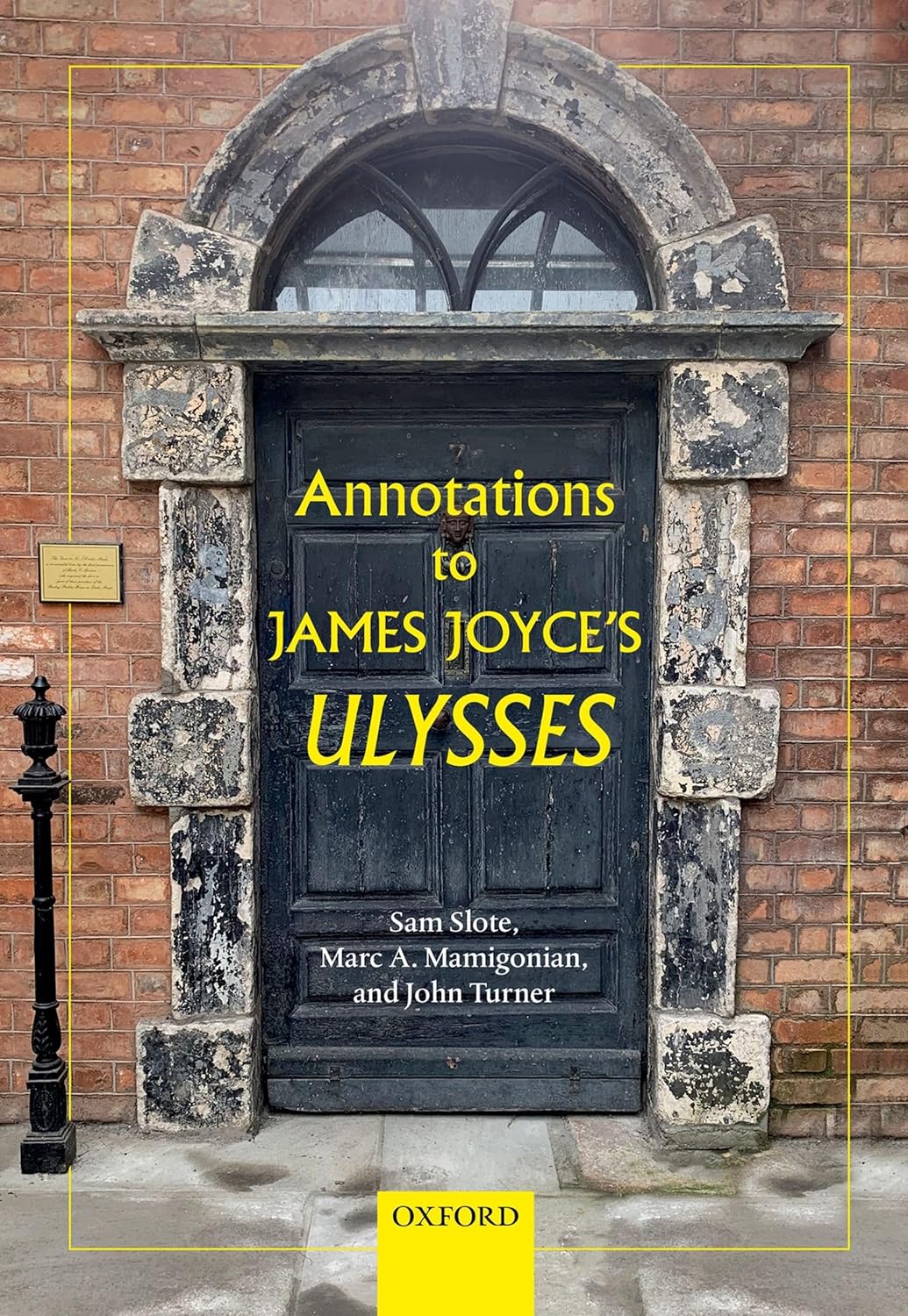
Annotations to James Joyce’s Ulysses
By Sam Slote, Marc A. Mamigonian & John Turner
Oxford University Press, 2022
This extraordinarily expensive book attempt to update Weldon Thornton’s Allusions in Ulysses and Don Gifford’s Ulysses Annotated. The three editors are the same team behind Alma Classic’s annotated edition of Ulysses; this seems to be a considerable expansion of their work.
Publisher’s Description: James Joyce’s Ulysses is filled with all sorts of references that can get in the way of many of its readers. This volume, with over 12,000 individual annotations (and more than double the word count of Ulysses itself), explains these references and allusions in a clear and compact manner and is designed to be accessible to novices and scholars alike. The annotations cover the full range of information referenced in Ulysses: a vast array of literary allusions, such as Shakespeare, Aristotle, Dante, Aquinas, slang from various eras and areas, foreign language words and phrases, Hiberno-English expressions, Catholic ritual and theology, Irish histories, Theosophy, Freemasonry, cricket, astronomy, fashion, boxing, heraldry, the symbolism of tattoos, horse racing, advertising slogans, nursery rhymes, superstitions, music-hall songs, references to Dublin topography precise enough for a city directory, and much more besides. The annotations reflect the latest scholarship and have been thoroughly reviewed by an international team of experts. They are designed to be accessible to first-time readers and college students and will also serve as a resource for Joycean specialists. The volume includes contemporaneous maps of Dublin to illustrate the cityscape’s relevance to Joyce’s novel. Unlike previous volumes of annotations, almost every note includes documentation about sources.
One Hundred Years of James Joyce’s Ulysses
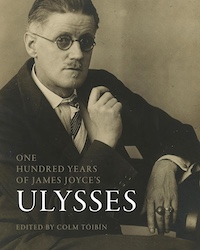
One Hundred Years of James Joyce’s Ulysses
Edited by Colm Tóibín
Penn State University Press, 2022
Publisher’s Description: Ulysses is widely regarded as the greatest novel of the twentieth century. Commemorating the 1922 publication of this modernist masterwork, One Hundred Years of James Joyce’s “Ulysses” tells the story of the writing, revising, printing, and censorship of the novel. Edited by world-renowned Irish novelist and literary critic Colm Tóibín, this book presents ten essays by preeminent Joyce scholars and by curators of his manuscripts and early editions, as well as an interview with Sean Kelly, the New York gallery owner who donated his extensive Joyce collection to The Morgan Library & Museum. Beginning with Tóibín’s expert interpretation of the Dublin context for Ulysses, the volume follows Joyce in Trieste, Zurich, and Paris from 1914 up through the novel’s publication―and the international scandal and fame that ensues. It draws on Joyce’s notebooks and letters, as well as extant manuscripts and proofs, to provide new insights into Joyce’s life, the narrative and place of Ulysses, and the printed book. Rich and illuminating, this volume is essential for scholars, fans, and readers of the novel. Along with the editor, contributors include Ronan Crowley, Maria DiBattista, Derick Dreher, Catherine Flynn, Anne Fogarty, Rick Gekoski, Joseph M. Hassett, James Maynard, and John McCourt.
Ulysses Polytropos: Essays on James Joyce’s Ulysses by Fritz Senn
Ulysses Polytropos: Essays on James Joyce’s Ulysses by Fritz Senn
By Fritz Senn; edited by Frances Ilmberger
Brill, 2022
Publisher’s Description: The reader will be delighted by the numerous gems gathered together and will find that Senn’s unflagging enthusiasm investigating the craftmanship of Joyce’s work infectious. Senn, a witty and thought provoking astute reader, shows that, even after one hundred years, there is still more to discover in James Joyce’s Ulysses.
Contents:
- Chapter 1—Joyce, Craftsman, Artificer
- Chapter 2—Parallax on Show
- Chapter 3—Joyce’s Sense of Rumour
- Chapter 4—Joyce’s Malleable Time
- Chapter 5—Joyce’s Different Conjugials
- Chapter 6—Mercurial Interpolations in Ulysses
- Chapter 7—Coincidental Joyce
- Chapter 8—Active Silences
- Chapter 9—Transmutation in Digress
- Chapter 10—The Joyce of Side Effects
- Chapter 11—Ulysses: Latent Coherence of Deviating Episodes
- Chapter 12—James Joyce’s Ulysses: Hell, Purgatory, Heaven in “Wandering Rocks”
- Chapter 13—In the Arms of Classics: Meta-Morpheus in “Eumaeus”
- Chapter 14—The Warped Modality of Joyce’s “Ithaca”
- Chapter 15—Events in Language: Joycean Extras
- Chapter 16—Ulyssean Histrionics in Everyday Life
- Chapter 17—Logodaedalian Bypaths: Evading the Obvious
- Chapter 18—The Odyssey through Joycean Lenses
Consuming Joyce: A Hundred Years of Ulysses in Ireland
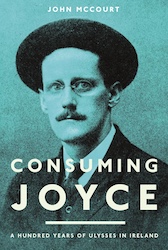
Consuming Joyce: A Hundred Years of Ulysses in Ireland
By John McCourt
Bloomsbury Academic, 2022
Publisher’s Description: James Joyce’s relationship with his homeland was a complicated and often vexed one. The publication of his masterwork Ulysses—referred to by The Quarterly Review as an “Odyssey of the sewer”—in 1922 was initially met with indifference and hostility within Ireland. This book tells the full story of the reception of Joyce and his best-known book in the country of his birth for the first time; a reception that evolved over the next hundred years, elevating Joyce from a writer reviled to one revered. Part reception study, part social history, this book uses the changing interpretations of Ulysses to explore the concurrent religious, social and political changes sweeping Ireland. From initially being a threat to the status quo, Ulysses became a way to market Ireland abroad and a manifesto for a better, more modern, open and tolerant, multi-ethnic country.
The Book About Everything: Eighteen Artists, Writers and Thinkers on James Joyce’s Ulysses
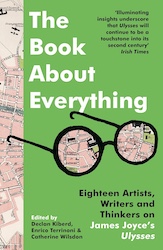
The Book About Everything: Eighteen Artists, Writers and Thinkers on James Joyce’s Ulysses
Edited by Declan Kiberd, Enrico Terrinoni, and Catherine Wilsdon
Apollo, 2022
Publisher’s Description: To celebrate the centenary of the publication of Ulysses, the most important literary work of the twentieth century, eighteen artists, writers and thinkers respond to an episode each of the great modernist text. Each essayist is an expert in one of the subjects treated in the novel, but what brings them together is a common love of Ulysses. Joseph O’Connor considers the music-saturated “Sirens” episode and David McWilliams writes about the bigotry and violence of nationalism on display in “Cyclops.” Irish obstetrician Rhona Mahony responds to “Oxen and the Sun,” set in a maternity hospital, journalist Lara Marlowe examines the “Aeolus episode,” which takes place in a newspaper office, and Irish philosopher Richard Kearney reflects on the erudite musings of Stephen Dedalus as he walks along Sandymount strand. The Book About Everything counters the perception of Ulysses as the sole preserve of academics and instead showcases readers’ responses to the book. It is a vivid, even eccentric collection, filled with life and Joycean spirit.
Death in Dublin During the Era of James Joyce’s Ulysses
Death in Dublin During the Era of James Joyce’s Ulysses
Patrick Callan
Routledge, 2024
Publisher’s Description: The funeral of Paddy Dignam in James Joyce’s Ulysses serves as the pivotal event of the “Hades” episode. This volume explores how Dignam’s interment in Glasnevin Cemetery allowed Joyce the freedom to consider the conventions, rituals and superstitions associated with death and burial in Dublin. Integrating the words and characters of Ulysses with its figurative locale, the book looks at the presence of Dublin in Ulysses, and Ulysses in Dublin. It emphasizes the highly visible public role assigned to death in Joyce’s world, while also appreciating how it is woven into the universe of Ulysses. The study examines the role of Glasnevin Cemetery―where the Joyce family plot was opened in 1880 and remained in use for eight decades―as well as the social and medical problems associated with life in Dublin, a city divided by class, status, wealth, and health. Nineteen burials took place in Glasnevin on 16 June 1904, and analysis of this group illuminates the role of undertakers and insurers, along with the importance of memorialization. This book is an important contribution to Joyce and Irish studies, as well as to international studies related to the treatment of the dead body and the development of garden cemeteries.
James Joyce and Samaritan Hospitality: Postcritical and Postsecular Reading in Dubliners and Ulysses
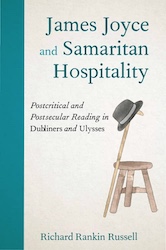
James Joyce and Samaritan Hospitality: Postcritical and Postsecular Reading in Dubliners and Ulysses
Richard Rankin Russell
Edinburgh University Press, 2024
Publisher’s Description: James Joyce and Samaritan Hospitality reads Dubliners and Ulysses through studies of hospitality, particularly that articulated in the Lukan parable of the Good Samaritan. It traces the origins of the novel in part to the physical attacks on Joyce in 1904 Dublin and 1907 Rome, showing how these incidents and the parable were incorporated into his short story “Grace” and throughout Ulysses, especially its last four episodes. Richard Rankin Russell discusses the rich theory of hospitality developed by Joyce and demonstrates that he sought to make us more charitable readers through his explorations and depictions of Samaritan hospitality.
Joyce Criticism
[Main Page | General Criticism | Dubliners | Portrait | Ulysses | Finnegans Wake]
Author: Allen B. Ruch & Bob Williams
Artwork: Loui Jover
Last Modified: 13 June 2024
Main Joyce Page: The Brazen Head
Contact: quail(at)shipwrecklibrary(dot)com

